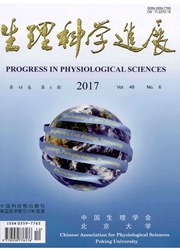

 中文摘要:
中文摘要:
junctophilin是目前公认的可兴奋细胞的胞膜与内(肌)质网耦联的分子基础。其可能的作用机制是以C端锚定在内(肌)质网上,通过N端的MORN结构域(MORN motif)与细胞膜相互作用。目前已知该分子在哺乳动物中存在四种亚型,在骨骼肌和心肌分别以Jp-1和Jp-2为主。junctophilin的低表达会导致细胞膜与内(肌)质网脱耦联,从而使心肌和骨骼肌兴奋收缩耦联效率降低,进而影响收缩能力。目前已发现junctophilin基因突变与心衰等疾病有关,因而junctophilin可能成为针对这些疾病的药物开发新靶点。
 英文摘要:
英文摘要:
Junctophilin is a molecule that couples endo (sarco)plasma membrane to plasma membrane in excitable cells. Its C terminal anchors into the endo( sarco)plasmic reticulum, while its N terminal interacts with plasma membrane via the MORN motifs. Mammalian junctophilin has four subtypes, among which Jp-1 and Jp-2 exist mainly in skeletal and cardiac muscle, respectively. In muscle cells, low expression of junctophilin decouples the sarcoplasmic reticulum from plasma membrane, decreases the efficiency of excitation-contraction coupling efficiency, and thereby compromises the contractility of heart and muscles. Many human diseases such as heart failure accompany with junctophilin mutations, so junctophilin may become a new target against these diseases.
 同期刊论文项目
同期刊论文项目
 同项目期刊论文
同项目期刊论文
 Transition of spiral calcium waves between multiple stable patterns can be triggered by a single cal
Transition of spiral calcium waves between multiple stable patterns can be triggered by a single cal Ca2+ cycling in heart cells from ground squirrels: adaptive strategies for intracellular Ca2+ homeos
Ca2+ cycling in heart cells from ground squirrels: adaptive strategies for intracellular Ca2+ homeos The structural and functional coupling between plasma membrane and sarcoplasmic reticulum in cardiac
The structural and functional coupling between plasma membrane and sarcoplasmic reticulum in cardiac Imaging superoxide flash and metabolism-coupled mitochondrial permeability transition in living anim
Imaging superoxide flash and metabolism-coupled mitochondrial permeability transition in living anim Neural recognition molecules CHL1 and NB-3 regulate apical dendrite orientation in the neocortex via
Neural recognition molecules CHL1 and NB-3 regulate apical dendrite orientation in the neocortex via 期刊信息
期刊信息
